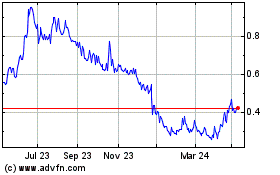By William Wilkes
BERLIN -- Rocketing demand and prices for lithium, coupled with
China's stranglehold on supply, are reviving interest in mining
Europe's reserves of the coveted metal some call white
petroleum.
Prices for lithium used in the batteries that power anything
from mobile phones to Teslas more than doubled to $21,000 a ton in
the past two years. Analysts expect the lithium-ion battery market
to surpass $90 billion by 2025 as electric vehicles become
commonplace and growing use of wind and sun power forces utilities
to invest in large electricity storage facilities.
But while European businesses use 25% of the world's lithium, a
group of Chinese companies has secured a potential stranglehold on
the Australian and South American mines that produce almost all the
world's battery-grade metal. That has sent a small group of
pioneers on a race to reopen European mines where the conditions
that gave rise to such lowly metals as tin have left lithium-rich
rocks and hot brines.
The race for European lithium echoes similar efforts in Japan to
track down metals for use in batteries amid concern about China's
hegemony over other minerals used in batteries and electric
vehicles.
For now, the best candidates for lithium are in Germany and the
Czech Republic where companies have successfully mined and produced
battery-grade lithium and hope to sell it to the numerous car
manufacturing plants dotted around central Europe. And in the U.K.,
Portugal and Sweden and Britain's Cornwall region, companies are
drilling bore holes and building 3-D maps of underground lithium
deposits.
One German firm, Deutsche Lithium GmbH, was recently granted a
30-year mining license and has already scooped out 100 tons of
lithium-yielding rock as it fine-tunes its extraction processes.
The company said it could eventually mine 15,000 tons a year.
Meanwhile, Australian mining company European Metals Ltd. has
extracted battery-grade lithium from its mine in the Czech Republic
and is finalizing a $400 million pitch to investors to scale up
production.
Geologists at Cornish Lithium Ltd., a startup scouring for
lithium in the U.K.'s historic tin-mining region of Cornwall, is
using satellite images to search for rock formations and vegetation
patterns typical of lithium-rich grounds -- and even poring over
the yellowing diaries of long-dead tin miners for clues as to where
lithium-rich underground springs may be hidden.
"It's a fascinating moment in the history of mining," said
Richard Shaw, geologist at the British Geological Survey.
Lithium's light weight makes it perfect for use in batteries,
which generate more electricity per unit of weight than any other
conceivable chemistry, according to researchers. Invented by Exxon
in the 1970s and made cheaper and safer since, lithium-ion
batteries are now ubiquitous.
For now, Chinese companies dominate global lithium supply. Last
year, auto maker Great Wall Motor bought a $28 million stake in
Pilbara Mineral, an Australian lithium mine and signed a contract
for a delivery of 150,000 tons of lithium-yielding spodumene from
the company's mine in Western Australia.
China's Ganfeng Lithium holds 20% of an Argentine project.
Chinese firm Tianqi Lithium's has attracted regulator attention in
Chile due to its $4 billion bid to buy a stake in SQM, the world's
second biggest lithium producer. Combined, the companies would
control 70% of the world lithium market.
But with Europe's car makers now set on mass-producing electric
vehicles, the need for the continent to secure its own lithium
reserves is gaining urgency.
"We hope to sell into the upswing in European electric car
manufacturing that'll take place in the mid-2020s," said Keith
Coughlan, director of European Metals Ltd., an Australian-Czech
firm looking for lithium on the Czech side of the border.
Lithium is easy to find. But only the richer seams or brines
will yield enough of the metal to make mining it profitable. If
enough dense deposits can be found, Europe could produce lithium
for around $4,000 per metric ton, according to Martin Bertau,
professor of mining and geology at the University of Freiberg. That
is in line with the cost of Australian production and well below
last year's peak price of $21,000.
Speculators probing the ground on either side of the
German-Czech border think they can profitably produce lithium from
zinnwaldite, a mineral often found encased in granite-like
rocks.
"Using historic mines," said Mr. Coughlan, the Australian
speculator said, "saves a huge amount of time and money compared to
digging a new mine."
Mr. Coughlan said his company would also mine tin at the site,
raising the productivity of the enterprise and offering a hedge if
lithium prices fall.
Gerard Reid, a founding partner at Alexa Capital, a London
corporate-finance firm specializing in energy technology and
infrastructure, said the small outfits now scouring the continent
would struggle to gain critical mass without the help of
deep-pocketed mining giants like Rio Tinto or Glencore.
But Armin Müller, founder of Deutsche Lithium, thinks German
auto makers, late to the electric-car revolution, might want a
local source of lithium if tweaks to Germany's capricious energy
policies mean car makers must account for the carbon footprint of
sourcing raw materials.
Mr. Müller's firm plans to keep the whole battery-grade lithium
production process in Saxony, East Germany, within driving distance
of Volkswagen's sprawling Wolfsburg car plant in the western state
of Lower Saxony.
Deutsche Lithium would mine and crush zinnwaldite in Altenberg
before transporting lithium fragments for chemical purification in
nearby Dresden. The processes would be governed by stringent German
and European laws.
Thomas Kerstin, Altenberg's mayor, said the town was supportive
of reopening the mine shafts closed after German reunification in
the 1990s -- an enticing prospect for the economically struggling
region.
"It feels like the town could get its soul back," Mr. Kerstin
said.
Write to William Wilkes at william.wilkes@wsj.com
(END) Dow Jones Newswires
April 13, 2018 05:44 ET (09:44 GMT)
Copyright (c) 2018 Dow Jones & Company, Inc.
European Metals (ASX:EMH)
Historical Stock Chart
From Mar 2024 to Apr 2024

European Metals (ASX:EMH)
Historical Stock Chart
From Apr 2023 to Apr 2024
